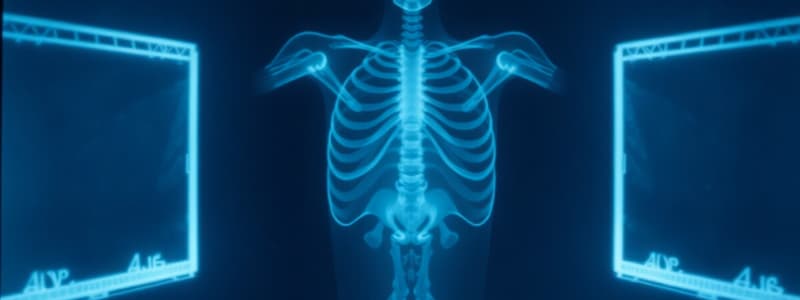Podcast
Questions and Answers
What is the purpose of chemical processing in radiographic film development?
What is the purpose of chemical processing in radiographic film development?
- To create the latent image
- To make the latent image visible (correct)
- To increase the film's contrast
- To store the film for future use
What is the consequence of stacking boxes of film horizontally?
What is the consequence of stacking boxes of film horizontally?
- It may cause pressure artifacts on the film (correct)
- It improves the organization of the film
- It prevents moisture damage
- It protects the film from light exposure
Which statement correctly describes the latent image?
Which statement correctly describes the latent image?
- It can be seen without chemical processing
- It is the same as the manifest image
- It is an invisible image formed by radiation exposure (correct)
- It is produced by exposure to water
Which film size is NOT mentioned as a common radiographic film size?
Which film size is NOT mentioned as a common radiographic film size?
What is the correct method for storing sheet film?
What is the correct method for storing sheet film?
What is the primary purpose of X-ray film?
What is the primary purpose of X-ray film?
Which layer of the X-ray film is primarily responsible for storing latent images?
Which layer of the X-ray film is primarily responsible for storing latent images?
What is NOT a recommended practice for electrical safety in a radiology environment?
What is NOT a recommended practice for electrical safety in a radiology environment?
What should staff do before handling radiological solutions or films?
What should staff do before handling radiological solutions or films?
What composition of the emulsion layer includes the majority percentage of silver halide?
What composition of the emulsion layer includes the majority percentage of silver halide?
What environmental factors can negatively affect X-ray film sensitivity?
What environmental factors can negatively affect X-ray film sensitivity?
Which safety feature should NOT be implemented in a radiological workspace?
Which safety feature should NOT be implemented in a radiological workspace?
What is the maximum thickness of X-ray film?
What is the maximum thickness of X-ray film?
Flashcards
Safe Lighting Level
Safe Lighting Level
The maximum safe lighting level based on film sensitivity
Adequate Ventilation
Adequate Ventilation
Necessary airflow to prevent chemical build-up
Fire Safety Exits
Fire Safety Exits
Multiple exits to ensure safe escape in case of fire
Electrical Equipment Placement
Electrical Equipment Placement
Signup and view all the flashcards
Earthing of Appliances
Earthing of Appliances
Signup and view all the flashcards
Trailing Cables
Trailing Cables
Signup and view all the flashcards
Pull-Cord Switching
Pull-Cord Switching
Signup and view all the flashcards
Chemical Handling Instructions
Chemical Handling Instructions
Signup and view all the flashcards
Chemical Expiry Dates
Chemical Expiry Dates
Signup and view all the flashcards
X-ray Film Purpose
X-ray Film Purpose
Signup and view all the flashcards
X-ray Film Composition
X-ray Film Composition
Signup and view all the flashcards
X-ray Film Interactions
X-ray Film Interactions
Signup and view all the flashcards
X-ray Film Layers
X-ray Film Layers
Signup and view all the flashcards
Emulsion (mammography film)
Emulsion (mammography film)
Signup and view all the flashcards
Latent Image
Latent Image
Signup and view all the flashcards
Manifest Image
Manifest Image
Signup and view all the flashcards
Mammography film size
Mammography film size
Signup and view all the flashcards
Radiographic film sizes
Radiographic film sizes
Signup and view all the flashcards
Film storage
Film storage
Signup and view all the flashcards
Film storage errors
Film storage errors
Signup and view all the flashcards




